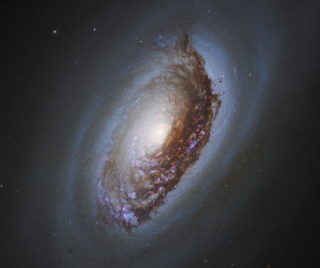
The Black Eye Galaxy is a relatively isolated spiral galaxy 17 million light-years away in the mildly northern constellation of Coma Berenices. It was discovered by Edward Pigott in March 1779, and independently by Johann Elert Bode in April of the same year, as well as by Charles Messier the next year. A dark band of absorbing dust partially in front of its bright nucleus gave rise to its nicknames of the "Black Eye", "Evil Eye", or "Sleeping Beauty" galaxy. M64 is well known among amateur astronomers due to its form in small telescopes and visibility across inhabited latitudes.
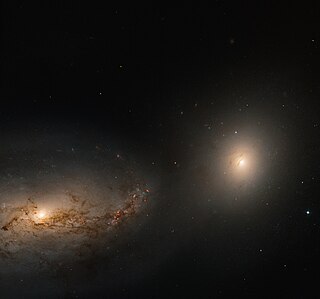
NGC 3227 is an intermediate spiral galaxy that is interacting with the dwarf elliptical galaxy NGC 3226. The two galaxies are one of several examples of a spiral with a dwarf elliptical companion that are listed in the Atlas of Peculiar Galaxies. Both galaxies may be found in the constellation Leo. It is a member of the NGC 3227 Group of galaxies, which is a member of the Leo II Groups, a series of galaxies and galaxy clusters strung out from the right edge of the Virgo Supercluster.

NGC 3226 is a dwarf elliptical galaxy that is interacting with the spiral galaxy NGC 3227. They were both discovered by German-British astronomer William Herschel on 15 February 1784. The two galaxies are one of several examples of a spiral with a dwarf elliptical companion that are listed in the Atlas of Peculiar Galaxies. Both galaxies may be found in the constellation Leo. It is a member of the NGC 3227 Group of galaxies, which is a member of the Leo II Groups, a series of galaxies and galaxy clusters strung out from the right edge of the Virgo Supercluster.

NGC 278 is an isolated spiral galaxy in the northern circumpolar constellation of Cassiopeia, near the southern constellation boundary with Andromeda. It lies at a distance of approximately 39 megalight-years from the Milky Way, giving it a physical scale of 190 ly (58 pc) per arcsecond. The galaxy was discovered on December 11, 1786 by German-born astronomer William Herschel. J. L. E. Dreyer described it as, "considerably bright, pretty large, round, 2 stars of 10th magnitude near".

NGC 7469 is an intermediate spiral galaxy in the constellation of Pegasus. NGC 7469 is located about 200 million light-years away from Earth, which means, given its apparent dimensions, that NGC 7469 is approximately 90,000 light-years across. It was discovered by William Herschel on November 12, 1784.

NGC 3367 is a barred spiral galaxy located in the constellation Leo. It is located at a distance of about 120 million light years from Earth, which, given its apparent dimensions, means that NGC 3367 is about 85,000 light years across. It was discovered by William Herschel on March 19, 1784.

NGC 7130 is a spiral galaxy located in the constellation Piscis Austrinus. It is located at a distance of about 220 million light years from Earth, which, given its apparent dimensions, means that NGC 7130 is about 100,000 light years across. It was discovered by John Herschel on September 25, 1834, and discovered independently by Lewis Swift on September 17, 1897. The location of the galaxy given in the New General Catalogue was off by 30 arcminutes in declination from the location of the galaxy.
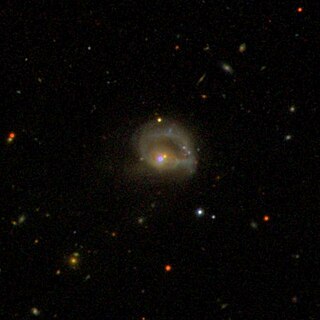
NGC 985 is a ring galaxy in the constellation of Cetus. It is located about 550 million light years away from Earth, which means, given its apparent dimensions, that NGC 985 is approximately 160,000 light years across. It was discovered by Francis Leavenworth in 1886. It is a type 1 Seyfert galaxy.

NGC 6951 is a barred spiral galaxy located in the constellation Cepheus. It is located at a distance of about 75 million light-years from Earth, which, given its apparent dimensions, means that NGC 6951 is about 100,000 light-years across. It was discovered by Jérôme Eugène Coggia in 1877 and independently by Lewis Swift in 1878.

NGC 1386 is a spiral galaxy located in the constellation Eridanus. It is located at a distance of circa 53 million light years from Earth, which, given its apparent dimensions, means that NGC 1386 is about 50,000 light years across. It is a Seyfert galaxy, the only one in Fornax Cluster.

NGC 5363 is a lenticular galaxy located in the constellation Virgo. It is located at a distance of circa 65 million light years from Earth, which, given its apparent dimensions, means that NGC 5363 is about 100,000 light years across. It was discovered by William Herschel on January 19, 1784. It is a member of the NGC 5364 Group of galaxies, itself one of the Virgo III Groups strung out to the east of the Virgo Supercluster of galaxies.

NGC 2273 is a barred spiral galaxy located in the constellation Lynx. It is located at a distance of circa 95 million light years from Earth, which, given its apparent dimensions, means that NGC 2273 is about 100,000 light years across. It was discovered by Nils Dunér on September 15, 1867.
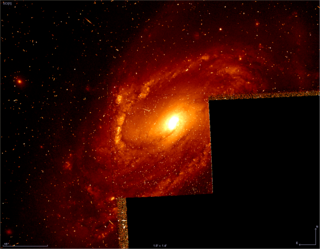
NGC 1241 is a spiral galaxy located in the constellation Eridanus. It is located at a distance of circa 150 million light years from Earth, which, given its apparent dimensions, means that NGC 1241 is about 140,000 light years across. It was discovered by William Herschel on January 10, 1785. It is classified as a Seyfert galaxy.

NGC 1142 is a distorted spiral galaxy in the constellation of Cetus. It is located about 370 million light years away from Earth, which means, given its apparent dimensions, that NGC 1142 is approximately 170,000 light years across. It is a type 2 Seyfert galaxy. It interacts with the elliptical galaxy NGC 1141.
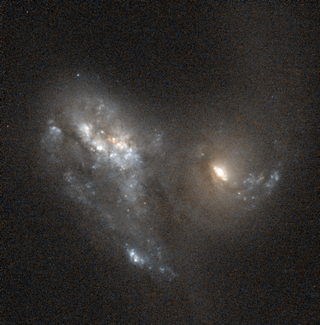
NGC 7592 is an interacting galaxy system located 300 million light years away in the constellation Aquarius. It was discovered by William Herschel on September 20, 1784. The total infrared luminosity is 1011.33 L☉, and thus it is categorised as a luminous infrared galaxy. One of the galaxies hosts a type 2 Seyfert nucleus.

NGC 3516 is a barred lenticular galaxy in the constellation of Ursa Major. NGC 3516 is located about 150 million light years away from Earth, which means, given its apparent dimensions, that NGC 3516 is approximately 100,000 light years across. It was discovered by William Herschel on April 3, 1785.
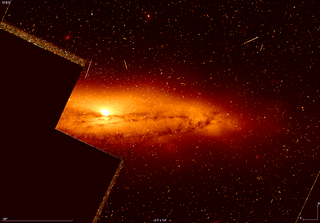
NGC 5506 is a spiral galaxy located in the constellation Virgo. It is located at a distance of about 75 million light years from Earth, which, given its apparent dimensions, means that NGC 5506 is about 80,000 light years across. It was discovered by William Herschel on April 15, 1787. It is a Seyfert galaxy.

NGC 4593 is a barred spiral galaxy located in the constellation Virgo. It is located at a distance of about 120 million light years from Earth, which, given its apparent dimensions, means that NGC 4593 is about 125,000 light years across. It was discovered by William Herschel on April 17, 1784. It is a Seyfert galaxy.

NGC 5135 is a barred spiral galaxy located in the constellation Hydra. It is located at a distance of about 200 million light years from Earth. It was discovered by John Herschel on May 8, 1834. It is a Seyfert galaxy.

NGC 7682 is a barred spiral galaxy in the constellation Pisces. It is located at a distance of about 180 million light years from Earth, which, given its apparent dimensions, means that NGC 7682 is about 65,000 light years across. It was discovered by Heinrich d'Arrest on September 23, 1864.




















